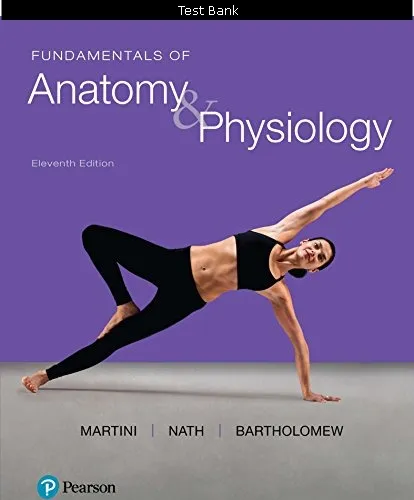Fundamentals of Anatomy & Physiology 11th Edition Test Bank
$55.00 Original price was: $55.00.$21.00Current price is: $21.00.
Digital item No Waiting Time Instant Download
Chapters: 29
Format: PDF
ISBN-13: 978-0134396026
ISBN-10: 0134396022
Publisher: Pearson
Authors: Frederic Martini, Judi Nath, Edwin Bartholomew
Description
Fundamentals of Anatomy & Physiology 11th Edition Test Bank
Table of Contents
1. An Introduction to Anatomy and Physiology
2. The Chemical Level of Organization
3. The Cellular Level of Organization
4. The Tissue Level of Organization
5. The Integumentary System
6. Bones and Bone Structure
7. The Axial Skeleton
8. The Appendicular Skeleton
9. Joints
10. Muscle Tissue
11. The Muscular System
12. Nervous Tissue
13. The Spinal Cord, Spinal Nerves, and Spinal Reflexes
14. The Brain and Cranial Nerves
15. Sensory Pathways and the Somatic Nervous System
16. The Autonomic Nervous System and Higher-Order Functions
17. The Special Senses
18. The Endocrine System
19. Blood
20. The Heart
21. Blood Vessels and Circulation
22. The Lymphatic System and Immunity
23. The Respiratory System
24. The Digestive System
25. Metabolism, Nutrition, and Energetics
26. The Urinary System
27. Fluid, Electrolyte, and Acid-Base Balance
28. The Reproductive System<
29. Development and Inheritance
Fundamentals of Anatomy and Physiology, 11e (Martini)
Chapter 1 An Introduction to Anatomy and Physiology
Multiple Choice Questions
1) Anatomy is to ________ as physiology is to ________.
A) function; form
B) form; structure
C) structure; function
D) structure; form
E) growth; form
Answer: C
Learning Outcome: 1-2
Bloom’s Taxonomy: Understanding
2) The analysis of the internal structure of individual cells is called
A) cytology.
B) histology.
C) embryology.
D) physiology.
E) anatomy.
Answer: A
Learning Outcome: 1-2
Bloom’s Taxonomy: Remembering
3) The study of the general form and superficial markings of an organism is called ________
anatomy.
A) gross
B) surface
C) systemic
D) regional
E) surgical
Answer: B
Learning Outcome: 1-2
Bloom’s Taxonomy: Remembering
4) Anatomical features that change during illness are studied in ________ anatomy.
A) gross
B) surface
C) microscopic
D) pathological
E) regional
Answer: D
Learning Outcome: 1-2
Bloom’s Taxonomy: Remembering
5) The study of the first two months of development is termed
A) histology.
B) embryology.
C) cytology.
D) pathology.
E) organology.
Answer: B
Learning Outcome: 1-2
Bloom’s Taxonomy: Remembering
6) The study of the function of specific organ systems is called
A) systemic physiology.
B) organ physiology.
C) cell physiology.
D) pathological physiology.
E) histology.
Answer: A
Learning Outcome: 1-2
Bloom’s Taxonomy: Remembering
7) Cardiovascular function is an example of
A) histophysiology.
B) organ physiology.
C) systemic physiology.
D) pathological physiology.
E) physiological chemistry.
Answer: C
Learning Outcome: 1-2
Bloom’s Taxonomy: Remembering
8) The study of the liver is to gross anatomy as the study of a liver cell is to
A) physiology.
B) regional anatomy.
C) cytology.
D) systemic anatomy.
E) radiographic anatomy.
Answer: C
Learning Outcome: 1-2
Bloom’s Taxonomy: Remembering
9) Identify the branch of biological science that studies the external and internal structure of the
body and the physical relationship among body parts.
A) genetics
B) physiology
C) embryology
D) anatomy
E) cytology
Answer: D
Learning Outcome: 1-2
Bloom’s Taxonomy: Remembering
10) Identify the branch of biological science that deals with the study of how living organisms
perform their vital functions.
A) genetics
B) physiology
C) embryology
D) anatomy
E) cytology
Answer: B
Learning Outcome: 1-2
Bloom’s Taxonomy: Remembering
11) The study of the changes in form that occur between conception and physical maturity is
called ________ anatomy.
A) developmental
B) clinical
C) systemic
D) embryological
E) physiological
Answer: A
Learning Outcome: 1-3
Bloom’s Taxonomy: Remembering
12) The study of the anatomical organization of specific areas of the body is called ________
anatomy.
A) gross
B) surface
C) systemic
D) regional
E) clinical
Answer: D
Learning Outcome: 1-2
Bloom’s Taxonomy: Remembering





Be the first to review “Fundamentals of Anatomy & Physiology 11th Edition Test Bank”